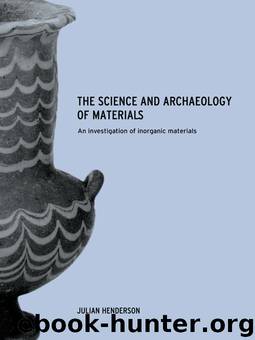The Science and Archaeology of Materials by Henderson Julian;

Author:Henderson, Julian;
Language: eng
Format: epub
Publisher: Routledge
Published: 2007-03-13T16:00:00+00:00
4.6.2 Green glazed wares and the development of glaze colour in celadons
The Chinese were involved in making green glazed ware for a span of some 3,500 years from the middle of the Shang Dynasty (c. 1500–1050 BC). Given the generic term green glaze’ there are subtle differences in the colours which need to be explained. Apart from the iron present which clearly contributes in a significant way to the greenware glaze colour (a range of 0.65–1.36% in Guan wares) another potential colorant is manganese oxide, but this generally occurs at low levels, of less that 0.1%. As mentioned in Section 4.3.5.2 an iron-green colour in glass and glazes can usually be attributed to ionic forms of iron, and normally to the presence of the reduced form, ferrous iron (Fe2+) (Portal 1997: 103). However, not only is it likely that, in fact, the iron is normally present as a mixture of two valances, ferrous and ferric (Fe3+), with a higher proportion of ferrous ions in some celadons, but the chemical environment in which it sits needs to be considered (see Section 4.3.5.2 ). For instance the total level of alkali in the glaze has an important effect because the higher the proportion of potassium oxide as opposed to soda, the greater the amount of light absorption occuring and hence the darker the hue.
In fact consideration of the atomic structure in silicate glazes reveals just how complex the coloration of transition metal ions, like those of iron, can be. When a transition metal assumes an ionic state, the ligand (the ions surrounding the colorant) depends on both the field strength and negative charge (i.e. provided by the oxygen). In transition metals, one of the energy shells (in this case the 3d sub-shell) is only partly filled with electrons and it is this which produces some of the colouring characteristics. When co-ordinated with other ions, such as Si4+ and Al3+ in celadons, the energy levels of the d electrons in transition metals are split (distorted) by the electric field produced by the co-ordinating ions. This splitting is sensitive to the arrangement of surrounding ions (the chemical environment); the result determines the glass colour. The theory of these effects is called the ‘ligand field’ theory. When higher energy level orbits in the iron ions are unoccupied, the electrons in lower energy level orbits absorb different wavelengths of light quanta in order to move up to the higher energy level quanta. It is this last energy transition that causes the glaze to appear green: the negative charge is bigger on the Fe3+ ligand than on Fe2+ and Fe3+ and this changes the quantum light resulting in a big absorption in the ultraviolet area.
Naturally other potential colorants make an important contribution. Glazes made at Longquan and Yaozhou have a yellowish brown colour, probably due to the formation of an iron-sulphur chromophore in the glaze (Scheurs and Brill 1984), which would occur under reducing conditions. In celadons made at Yue, translucency is augmented by the precipitation of
Download
This site does not store any files on its server. We only index and link to content provided by other sites. Please contact the content providers to delete copyright contents if any and email us, we'll remove relevant links or contents immediately.
| Concrete | Extraction & Processing |
| Fracture Mechanics | Materials Science |
| Metallurgy | Polymers & Textiles |
| Strength of Materials | Testing |
Whiskies Galore by Ian Buxton(41621)
Introduction to Aircraft Design (Cambridge Aerospace Series) by John P. Fielding(32951)
Small Unmanned Fixed-wing Aircraft Design by Andrew J. Keane Andras Sobester James P. Scanlan & András Sóbester & James P. Scanlan(32623)
Craft Beer for the Homebrewer by Michael Agnew(18005)
Turbulence by E. J. Noyes(7805)
The Complete Stick Figure Physics Tutorials by Allen Sarah(7199)
Kaplan MCAT General Chemistry Review by Kaplan(6703)
The Thirst by Nesbo Jo(6586)
Bad Blood by John Carreyrou(6371)
Modelling of Convective Heat and Mass Transfer in Rotating Flows by Igor V. Shevchuk(6282)
Learning SQL by Alan Beaulieu(6094)
Weapons of Math Destruction by Cathy O'Neil(5960)
Man-made Catastrophes and Risk Information Concealment by Dmitry Chernov & Didier Sornette(5770)
Digital Minimalism by Cal Newport;(5487)
Life 3.0: Being Human in the Age of Artificial Intelligence by Tegmark Max(5280)
iGen by Jean M. Twenge(5231)
Secrets of Antigravity Propulsion: Tesla, UFOs, and Classified Aerospace Technology by Ph.D. Paul A. Laviolette(5148)
Design of Trajectory Optimization Approach for Space Maneuver Vehicle Skip Entry Problems by Runqi Chai & Al Savvaris & Antonios Tsourdos & Senchun Chai(4897)
Electronic Devices & Circuits by Jacob Millman & Christos C. Halkias(4803)
